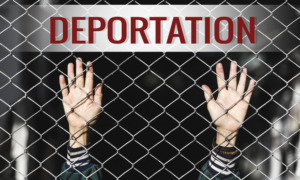The Adam Walsh Child Protection and Safety Act, signed by President Bush in July, was widely hailed as one of the most important child-protection laws to be enacted in years. But while the new law got lots of laudatory media coverage for its worthwhile objective – to protect children from sex offenders – its details worry some youth advocates even as others praise it.
“This new law will change the way we deal with child predators across this nation,” Ernie Allen, CEO of the National Center for Missing and Exploited Children (NCMEC), said in a prepared statement.
“This is very dangerous legislation,” said Elizabeth Gladden Kehoe, senior staff attorney with the Washington, D.C.-based National Juvenile Defender Center, which works to improve counsel for justice-involved youth.
A major change is that youths convicted of serious sex crimes in juvenile court must be included in state criminal registration and notification systems. The law also authorizes millions of dollars in new grants for youth programs.
The act – named after the murdered son of activist and television host John Walsh – is designed to impose nationwide uniformity to what is now a state-by-state patchwork of sex offender registration and notification systems.
It mandates that states include in those systems youth ages 14 and older who are convicted of serious sexual abuse, as well as youth convicted as adults for similar crimes. The act defines serious sexual abuse as aggravated sexual abuse, abusive sexual contact against minors not yet 13, kidnapping of a minor, and attempts or conspiracies to commit such crimes. The U.S. attorney general will issue guidelines for how states should craft their systems, including more precisely defining the relevant crimes.
While several states permit juvenile listings in sex offender registries, this is the first national directive that they must do so. States that fail to implement the new requirements by 2008 lose 10 percent of their annual U.S. Department of Justice (DOJ) anti-crime funding allocation.
There are about 442,000 offenders listed in the federal government’s National Sex Offender Public Registry, which is linked to state registration system data.
It’s unclear how many youthful sexual offenders are on state registries or how many might be added because of the new law, said Melissa Sickmund, senior researcher with the Pittsburgh-based National Center for Juvenile Justice.
Worries
A number of juvenile justice experts expressed concern about the unintended consequences of the law.
“Juvenile sex offenders are clearly different than adult sex offenders. All the research shows that,” Kehoe said. By subjecting some juveniles to potential lifetime sex offender registration, she said, “I think we’re just sort of throwing away the key on some of these kids.”
Sex offenders must keep their registration data current for 15 years to life, depending on the severity of their crimes, and appear in person to authorities regularly to have their pictures taken and verify registration information. In most cases, the information is to be made public on the Internet.
Allen of NCMEC – a Virginia-based nonprofit that reports on child exploitation to law enforcement and helps locate missing children – said in an interview that the act is meant only for the most serious sex offenders. He said it is not intended in cases where, for instance, a 17-year-old has consensual sex with a 15-year-old.
“It’s important that all offenders not be treated as if they are alike, and that there needs to be a meaningful assessment of the risk that each offender poses for re-offense,” Allen said.
Others argued that grouping youth and adult sex offenders in the same categories is misguided.
“An adult pedophile is a very different kind of person than a child who’s maybe 14 who engages in some sexual behavior with a younger child,” Sickmund said. “Some of those kids may in fact develop into the pedophiles. I don’t know that we have the ability to distinguish those from the other kids who are themselves messed up kids.”
Forcing youth to register as sex offenders will “create all kinds of problems for them socially and personally,” Kehoe said. “It’s going to be harder for them to get a job.”
Background Checks
The Walsh Act also requires the U.S. attorney general to provide NCMEC and government child welfare agencies with access to national crime information databases if they are supporting law enforcement or if they are investigating child abuse, neglect and exploitation.
The law requires states to conduct complete background checks before approving any foster or adoptive placements, and to check national crime information databases and state child abuse registries for criminal information on prospective foster and adoptive parents.
A background check requirement in the 1997 Adoption and Safe Families Act included a provision that let states run checks according to their own guidelines. As of 2004, nine states, including New York and California, had exercised this option.
These states often employ “rebuttable presumptions,” which allow them to decide on a case-by-case basis that prospective foster or adoptive parents with criminal records merit consideration to become guardians if the offenses bear no relevance to their caregiver abilities.
But the Walsh act forces states to disqualify any potential guardian with a criminal record.
"The rebuttable presumption is thrown out,” said Tim Briceland-Betts, co-director for government affairs at the D.C.-based Child Welfare League of America (CWLA).
JooYeun Chang, staff attorney with the D.C.-based Children’s Defense Fund, added that Congress should not have linked sexual predation with child home placements, “because there was no evidence that there was any connection between sexual predators and caregivers who may have had some other type of criminal background.”
The law also calls for the creation of a National Child Abuse Registry, but authorizes $1 million to study the issue for one year first. Briceland-Betts said that while CWLA “applauds” attempts to track child abuse, such a registry is fraught with complications because of differing state standards of abuse.
“These definitions, these standards, they matter, particularly when you are talking about people’s lives and their futures,” he said.
The measure is available at http://frwebgate.access.gpo.gov/cgi-bin/getdoc.cgi?dbname=109_cong_bills&docid=f:h4472enr.txt.pdf.
|
Other provisions in the law, P.L. 109-248, include: • Authorization for $58.5 million over five years for Big Brothers Big Sisters of America for at-risk youth mentoring programs; reauthorization of the National Police Athletic League (PAL) Youth Enrichment Act through 2010; $30 million over three years for juvenile sex offender treatment; and $20 million over five years for state and local child fingerprinting programs. • Federal law enforcement authority to locate and apprehend violators of state and local sex offender registration requirements. • Liability protections for NCMEC stemming from information passed to law enforcement from its CyberTipline, which the public uses to report Internet-related child sexual exploitation. Allen said the law provides NCMEC, which receives $24 million annually from DOJ, with protection against “inadvertent violation of law in handling this kind of content.” Gross negligence or willful misconduct by NCMEC is not protected. • An $18 million fiscal 2007 authorization for Project Safe Childhood, for U.S. attorneys’ child-exploitation case work and Internet Crimes Against Children law enforcement task forces. |































